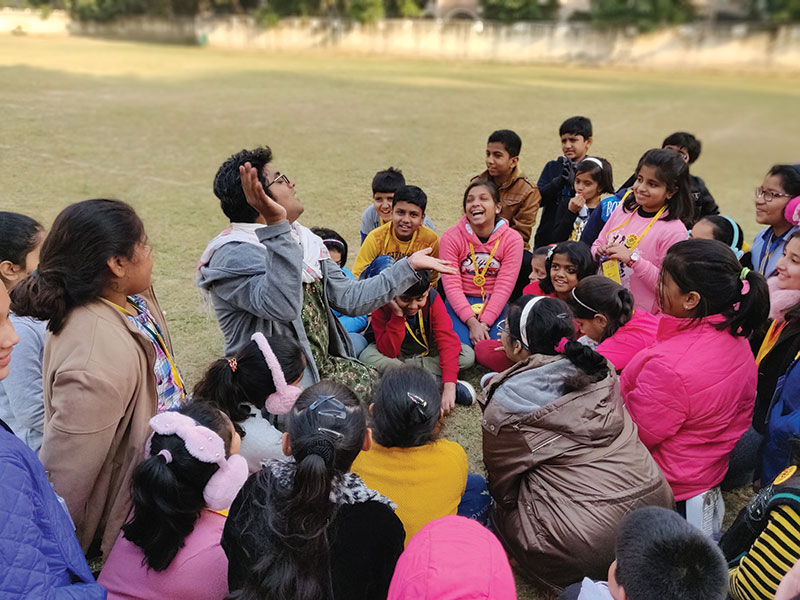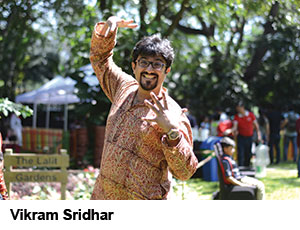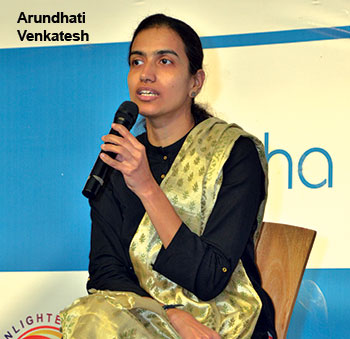The most enduring and proven pedagogy for engaging children and enhancing their knowledge, comprehension and recall capabilities is storytelling – Jayalakshmi Vaidhyanathan

In the Internet age, there are limitless resources and new-fangled techniques to help children ‘learn’ and improve their memorisation capabilities. Yet perhaps the most enduring and proven pedagogy for engaging children and enhancing their knowledge, comprehension and recall capabilities is storytelling. It is the oldest form of communication between humans that has existed ever since language was invented, and since several millennia well-told stories have captivated and engaged young and old alike.
Stories and the human brain
Recent neuroscience studies reiterate that stories are one of the most effective ways to inspire children to learn and retain information, strongly connecting the recipient to the message. In 2012, Kendall Haven, an internationally-recognised expert on story structure, and her team of researchers working under the auspices of the Narrative Network Project funded by the U.S. Department of Defense, conducted a series of cognitive science experiments investigating how to best create effective story structures for the purposes of education, communication and organisational leadership. Haven concluded that “human brains are literally hard-wired to make sense, to think, to understand and to remember in specific story terms and elements. Your hard-wired Neural Story Net (NSN) is responsible for turning incoming information and experiences into story terms in order to make it make sense. Nothing reaches your conscious mind and memory without first being massaged into story form by your NSN.”
Another research study conducted in 2015 by Diann Moorman, professor at the University of Georgia, found that students recall information tied to storytelling better than material presented without storytelling. Using data collected from in-class examinations and on-line quizzes, she and her colleagues found that information related to storytelling is recalled more successfully than material presented without storytelling.
One theory put forward by neuroscientists to explain why humans get a kick out of listening to stories is that the neural pathways through which we learn taps into the same pleasure networks in the brain that are activated by drugs and give people a high. The chemical centre known as the ‘mu-opioid receptor’ is found in the areas that process sensory information and memories. This is what stimulates an innate urge to listen to stories. These receptors become active when the brain is interpreting the information it is receiving from a story, which can be told in various forms such as images, written words, movies or listening. During a story-telling session, endorphins that stimulate mu-opioid receptors are released, prompting pleasurable sentiments. With children, this effect does not wear out, which explains their enthusiasm for hearing the same bedtime story night after night.
 Bangalore-based Vikram Sridhar, curator of literary festivals and performance storyteller, believes that storytelling is the strongest medium of conservation and knowledge sharing. “Stories are containers used to transfer knowledge and information. They are like bowls that hold water and if the water is knowledge, stories are channels that help transfer this knowledge to listeners. In education, stories are a powerful medium to enable children to understand, comprehend and retain information and facts,” says Sridhar, who travels across India narrating stories to teachers, children, parents, and community workers.
Bangalore-based Vikram Sridhar, curator of literary festivals and performance storyteller, believes that storytelling is the strongest medium of conservation and knowledge sharing. “Stories are containers used to transfer knowledge and information. They are like bowls that hold water and if the water is knowledge, stories are channels that help transfer this knowledge to listeners. In education, stories are a powerful medium to enable children to understand, comprehend and retain information and facts,” says Sridhar, who travels across India narrating stories to teachers, children, parents, and community workers.
Using stories in education
Stories are like a skeleton to which one can add flesh and blood to form body. In numerous NCERT textbooks, languages and the social sciences are learnt through case studies. In maths and science too, stories enable students to better understand concepts and ideas.
Comments Ameen Haque, Bangalore-based story coach and founder of Storywallahs, a firm which helps schools harness the power of storytelling: “The prime responsibility of a teacher is to fully engage children. The best teachers are always good storytellers. The hallmark of a good teacher is that she knows how to convert a boring lesson into a great story. When children become engaged in a lesson or subject, learning outcomes are certain to be good. At home, parents can and should, use stories to teach children.”
Pratham Books, established in 2004 by the highly-respected education NGO Pratham Education Foundation, has published 2,500-plus storybooks in multiple languages and has recently launched an online digital platform StoryWeaver, which provides open access to over 13,000 storybooks in 155 languages. Open licensing allows these stories to be translated, remixed, or re-levelled to suit the needs of children reading them. StoryWeaver also teaches teachers, parents and children to create their own story-lessons.
 Bangalore-based author Arundhati Venkatesh, who has won several awards for her children’s books in the Petu Pumpkin and Bookasura series, says stories — whether transmitted orally like the epics of ancient civilizations, written, drawn on mud houses, cave and temple walls or performed — have existed since centuries. “A good story stays with us because it lets us feel emotions and experience an imagined narrative as though it were real. Well-told and well-written stories have a powerful impact on children, because they are more curious and creative, helping them to process and retain information easily. A child is certainly more likely to remember a story than a bland classroom lecture,” says Venkatesh.
Bangalore-based author Arundhati Venkatesh, who has won several awards for her children’s books in the Petu Pumpkin and Bookasura series, says stories — whether transmitted orally like the epics of ancient civilizations, written, drawn on mud houses, cave and temple walls or performed — have existed since centuries. “A good story stays with us because it lets us feel emotions and experience an imagined narrative as though it were real. Well-told and well-written stories have a powerful impact on children, because they are more curious and creative, helping them to process and retain information easily. A child is certainly more likely to remember a story than a bland classroom lecture,” says Venkatesh.
Create your story-lesson
Therefore, it’s important that parents and teachers or parents-cum-teachers make efforts to create stories to teach subjects from maths to music. We present some guidelines for creating story-lessons.
Character. Choose story characters well, and attribute unusual habits or mindsets to each character. Choose evocative names or distinctive physiognomy for added effect. Example: In a geography lesson on rivers, rivers could be given human characteristics or named after tribes living near the river.
Plot. What’s the theme of the story? What problems/challenges need to be resolved? How do they affect the main characters, and who or what will help to solve them? Example: All the fish in a river are in danger of dying because of factories dumping waste into it. The people living nearby are in danger of slow poisoning because they consume the fish and water from the river. Can this problem be resolved through cleaning the river, disinfecting it, etc?
Setting and atmosphere. Set your story in a real or imaginary place. Help your audience experience the sounds, smells, sights and feel of the place. For example, are the characters living near the Amazon or Indus rivers? Can they feel the velvety moss on the rocks; hear the sudden screech of a bird, as it drops a piece of fruit into the river, creating beautiful ripples?
Also read: Reviving the art of storytelling: Interview with Shreya Biswas, prominent storyteller


























